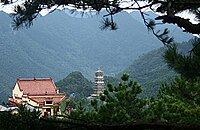geo.wikisort.org - Mountains
Mount Jiuhua (simplified Chinese: 九华山; traditional Chinese: 九華山; pinyin: Jǐuhuà Shān; lit. 'Nine Glorious Mountains') located in Chizhou, Anhui Province in China is an important Buddhist site and natural scenic spot. It is one of the four famous Buddhist mountains in China, one of the first batch of 5A level scenic spots in China, one of the first batch of natural and cultural heritage sites in China, and the main scenic spot of "two mountains and one lake" (Jiuhua Mountain, Taiping Lake, Huangshan) tourism development strategy in Anhui Province. The planned area of the scenic spot is 120 square kilometers, and the protected area is 174 square kilometers, which is composed of 11 scenic spots.[1][2]
This article needs additional citations for verification. (September 2017) |
| Mount Jiuhua | |
|---|---|
 A view from Jiuhuashan's Lesser Tiantai peak | |
| Highest point | |
| Elevation | 1,342 m (4,403 ft) |
History

Mount Jiuhua was called Mount Lingyang during the time of the Han Dynasty. It was called Mount Jiuzi (九子山) in Liang and Chen Dynasties of South Dynasties. A legend says that the great poet Li Bai of Tang Dynasty travelled here and wrote "Magic is divided to two branches, sacred mountain generates nine glories." (妙有分二气,灵山开九华), giving rise to its name Mount Jiuhua.
Mount Jiuhua is located in the southeastern part of Chizhou City, in Quingyang County of Anhui Province. The gross area reaches 120 square kilometers, while the protection area reaches 114 square kilometers. Shiwang Peak is the highest one with an elevation of 1342 meters above sea level. Together with Wutai Mountain in Shanxi, Emei Mountain in Sichuan and Putuo Mountain in Zhejiang. Jiuhua Mountain is called one of the four great Buddhist mountains in China. In 719 AD, Kim Qiaoque, a Silla prince (today's Qingzhou city in South Korea) came to Jiuhua Mountain and cultivated himself for 75 years. He died at 99 years of age, his corporeal body stayed intact. Because he was very similar in appearance to Dizang Buddhisattva, the monks there believed Dizang Boddhisattva was reincarnated in him, as a result, Jiuhua Mountain became the place to hold rites for Dizang Boddhisatva. During the golden periods of the Ming and Qing dynasties, there were as many as 360 temples and 4,000 to 5,000 monks and nuns. The mountain is not only famous for its Buddhist culture but also noted for its natural landscapes featuring old pines, green bamboo forests, strange rocks, waterfalls, streams and caves.
Mount Jiuhua was originally known as Jiuzi (Nine-Peak) Mountain. But ever since Li Bai, the celebrated poet in the Tang Dynasty wrote of the mountain,
Sailing down the Jiujiang River the other day, I saw the Jiuhua Peaks in the distance. Looking like a heavenly river hanging in heaven, Its green water embroidering cotton rose hibiscuses.

the mountain was renamed Jiuhua Mountain. As a popular pilgrimage destination, it was very famous in the southeastern part of China and became one of the four holy mountains of Buddhism. Since its opening in 1979, Jiuhua Mountain, with its abundant Buddhist culture and uniquely attractive scenery, has enjoyed a high reputation in southeast Asia, South Korea and Japan. It is known as the mountain of Dizang Buddhisattva and for having a large number of whole Buddhist relics. There are 99 peaks in the area, among them Shiwang Peak, Lotus Peak, and others.
Subsequently certified as a National Geopark, and then as a regional geopark (Asia Pacific Geopark Network), it was admitted as a UNESCO Global Geopark in 2019.
Temples
Some renowned temples located at Mount Jiuhua include:
- Ganlu Temple (Mount Jiuhua)
- Tiantai Temple (Mount Jiuhua)
- Zhiyuan Temple (Mount Jiuhua)
- Huacheng Temple
- Baisui Palace
- Zhantalin
- Baisuigong Temple
- Qiyuansi Temple
- Roushen Temple
- Tianchi Temple
- Dabeilou Temple
Gallery
- A view of China's Jiuhuashan (mountains), seen from a distance.
- Higher Daxiong Baodian, located on Greater Tiantai peak
- Wanfo Pagoda at Mount Jiuhua
- China's Jiuhuashan (mountains): a view of multiple peaks, seen from Dizang Dian (temple).
References
- "Jiuhuashan". www.hceis.com.
- "九华山概况-九华山风景区". www.jiuhuashan.gov.cn. Retrieved 2020-01-04.
External links
На других языках
[de] Jiuhua Shan
Das Jiuhua-Gebirge (chinesisch .mw-parser-output .Hant{font-size:110%}九華山 / .mw-parser-output .Hans{font-size:110%}九华山; Pinyin: Jǐuhuá Shān) zählt zu den vier heiligen Bergen des chinesischen Buddhismus. Es liegt im Kreis Qingyang in der chinesischen Provinz Anhui und ist berühmt für seine schöne Landschaft und vielen Tempel.- [en] Mount Jiuhua
[fr] Mont Jiuhua
Le mont Jiuhua (sinogrammes simplifiés : 九华山 ; sinogrammes traditionnels : 九華山 ; hanyu pinyin : jiǔhuáshān ; littéralement « montagne des neuf splendeurs ») ou Jiuhua Shan, est l'une des quatre montagnes sacrées bouddhiques de Chine, consacré au bodhisattva Ksitigarbha. Situé dans la province de l'Anhui, il comporte 99 sommets, et est célèbre pour ses paysages et ses temples anciens.[ru] Цзюхуашань
Цзюхуашань (кит. трад. 九華山, упр. 九华山, пиньинь Jiǔ huá Shān, буквально: «Горы девяти прелестей») — одна из четырёх священных гор китайского буддизма, расположенная в уезде Цинъян городского округа Чичжоу провинции Аньхой.Другой контент может иметь иную лицензию. Перед использованием материалов сайта WikiSort.org внимательно изучите правила лицензирования конкретных элементов наполнения сайта.
WikiSort.org - проект по пересортировке и дополнению контента Википедии



